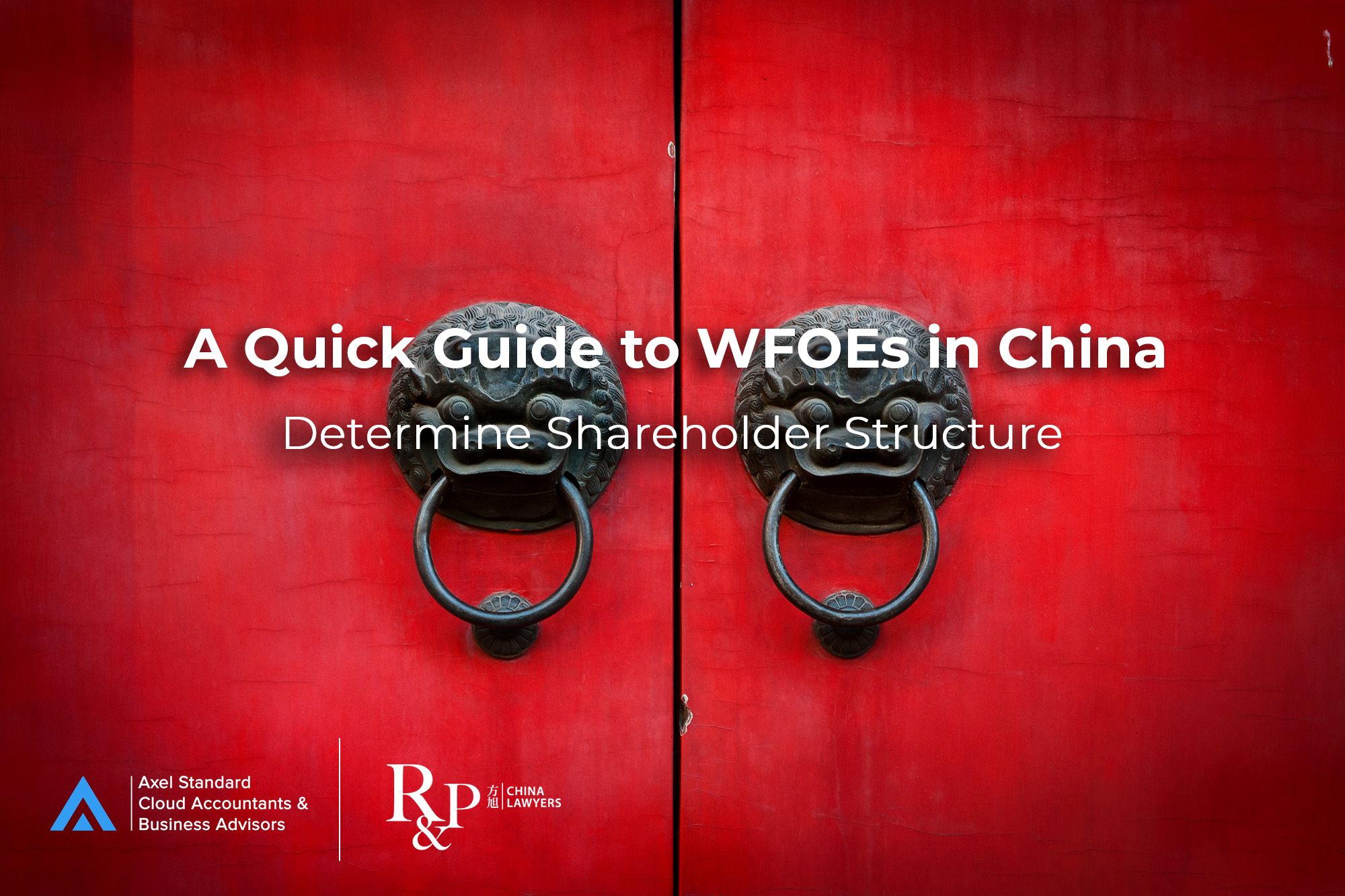Last Thursday, 27 November, the British Chamber of Commerce in China was delighted to co-host…

[Members Publication] A Quick Guide to WFOEs in China: Determine Shareholder Structure
What to Consider When Determining the Best Shareholder Structure for Your WFOE in China: A Quick Guide
Determining a shareholder structure for a wholly foreign owned enterprise in China requires the consideration of both short-term realities and long-term strategies.
In this article, we analyze several shareholder structures for wholly foreign owned enterprises in China. To make it easier, we broke it down and contrasted between 6 most common areas of concern when determining a shareholder structure: risk, tax, cost, flexibility, investment and expansion.
Foreign investors should use this article as a guideline to help determine the shareholder structure, which best matches your plan for success.
Case Study
an entrepreneur with over thirty-years’ experience in his field, and his own company for twenty-years providing engineering services to the automotive industry in Germany, decides to set up a company in China. This Wholly Foreign Owned Enterprise (WFOE) makes cooperation with his Chinese partners, manufacturers and suppliers much easier.
The entrepreneur decides to set it up as an individual in order to create the company quickly and without much consideration for alternative holding structures. After several years of operations in China, the company is running well, and he wants to expand. The company in Germany does not have enough cash flow to fund expansion initiatives, and the entrepreneur doesn’t have enough funds available to him either, so he decides to look for investment. During investment negotiations, investors request a Special Purpose Vehicle (SPV) in Hong Kong in order to contribute their funds.
The entrepreneur and investors make an agreement on the percentage of shares and set up a Hong Kong company to replace the German as the shareholder of the WFOE. Considerations are made to administrative procedures in changing the WFOE’s shareholders and potential capital gains tax liabilities.
All investors outline their expansion plan in a shareholder agreement for this new structure with the WFOE in China, which will be implemented via opening new WFOEs under SPV or through branch offices via the existing WFOE.
Background
Whether you’re a multinational company looking to expand your market, or a budding entrepreneur as in the case study above, China is a land of endless opportunity. However, creating the correct business strategy and company structure go hand-in-hand with success and mitigating unnecessary costs or complications.
For the first time, in the 2nd quarter of 2018, China surpassed North America in attracting venture capital worldwide. At that time, startups in China accounted for 47 percent of the global VC funding compared with a combined 35 percent for the U.S. and Canada. As more investment enters China, it is clear the world’s attention is pivoting, and now is the perfect time to consider bringing your venture to the East.
As a foreign investment vehicle, you have several options in setting up a business: Representative Office, Joint Venture, Foreign Invested Partnership, and Wholly Foreign Owned Enterprise. For its independence, Wholly Foreign Owned Enterprises are often the most preferred business to start in China.
Wholly Foreign Owned Enterprises allow foreign parties, individuals or corporate entities, to incorporate a foreign-owned liability company. The unique feature of a WFOE is that involvement of a mainland Chinese investor is not required, unlike some other investment vehicles in China.
However, creating the best WFOE structure is complicated, and requires the consideration of many factors. Before we dive into the different factors, it’s important to understand the terminologies of the WFOE. Each WFOE requires: shareholder, legal representative and supervisor.
Definitions:
- Shareholders are those who make capital contributions and represent the highest authority in the company. In order to qualify as a WFOE, 100% of the shares needs to be owned by a foreign entity or individual or several foreign entities or several foreign individuals.
- Legal representative is required for every business established in China, whether domestic or foreign. He/she is the main principal of the company and is an individual with the legal power to represent and enter into binding obligations on behalf of the company, as well as the individual who bears most responsibility for wrongdoing in accordance with the law or articles of association of the company.
- Executive Director or Board of Directors depending on the needs of the shareholder to manage the direct the company. For a simple and straight-forward governance process, the Executive Director may be sufficient. For more complex companies, e.g. when there are several shareholders, a Board of Directors may be more suitable. Such a board needs to consist of at least 3 people, among them a Chairperson of the Board.
- Supervisor, or Supervisor Board of at least 3 Supervisors, has the authority to supervise the company directors and management through, for example, investigation either by themselves or through a third party. Directors and senior managers have to provide relevant information to Supervisors and are prohibited from hindering their function.
Shareholder as an Individual
This company structure places the primary shareholder as an individual person.
- Risk
This places the most amount of risk on the individual shareholder who acts as a natural and legal person, rather than a corporation that only acts as a legal person and often limits liability and protects its natural person shareholders. If the company acquires debts or issues with authorities, not only will the legal representative as an individual be liable, so will the shareholders.
- Tax
For collecting dividends, individual shareholders will not be taxed by the Chinese government on dividends paid, as long as they are not a tax resident in China, which however also exposes them to tax liability on worldwide income. The individual may also have taxes to bare in his/her country of citizenship.
- Cost
Compared to other corporate registration processes in China available to foreign investors, it is relatively inexpensive to start a company as an individual in China.
- Flexibility
Setting up a WFOE as an individual is flexible in terms of speed and cost. The shareholder may choose to sell the company going through administrative and tax processes in China and their home jurisdictions.
- Investment
Raising capital as an individual shareholder is the most challenging and the riskiest solution for WFOEs in China. An individual may only have limited funds to invest and limited collateral to borrow against, but investors may provide funds based on skill or experience of the individual.
- Expansion
Expansion is somewhat limited since an individual may not be in a position to raise the necessary capital required to grow further in China and attract the necessary expertise from partners. An individual shareholder may therefore operate a relatively small structure and may need to rely on the WFOE that is set up in China to expand to other corporations, branches or partnerships.
Shareholder as Original Business Expanding to China
Allowing for direct corporation ownership with your foreign business entity removes the liability and risk on shareholders as an individual; however, there are other factors to consider:
- Risk
It’s important to note that although this does not place risk on an individual, there is risk if the corporation collects debts or liabilities in China and wants to close. Declaring bankruptcy or settling debts would be required before the entity would be able to close, risking corporation and shareholder reputation in China or difficulties with authorities.
- Tax
Dividend payments from the WFOE to the original corporation will incur a 10% withholding tax, making this structure the costliest tax method of the WFOE shareholder structures. Dividend tax rates may be lowered depending on tax treaties China has signed with the foreign corporation’s home jurisdiction.
- Cost
The registration of a WFOE in China with a corporate shareholder is relatively straight forward and comparable to the registration with an individual shareholder from a cost perspective.
- Flexibility
There’s comparative flexibility with access to funding (via capital or revenue) and staff to draw from the original business. The shareholder may choose to sell the company going through administrative and tax processes in China and their home jurisdictions.
- Investment
As an operating company, the shareholder may generate cash from their own business operations to invest into the WFOE in China and has assets and a track record against which it can raise money from investors or banks.
- Expansion
Depending on the nature and development of the business in China, the company shareholder may be at a disadvantage. For example, when the business in China becomes larger relative to the home market’s business and requires additional expertise / capital.
Shareholder as an: SPV Company
An SPV is a special purpose vehicle that usually doesn’t have traditional business operations, but which derives its value from pooling investors’ funds and legally separating it from operating companies and other funds of investors. Choosing Hong Kong or another jurisdiction to register the special purpose vehicle as a shareholder structure, can provide a variety of benefits for companies with large ambitions in China. Less risk, lower tax and the potential of an IPO are several obvious reasons to choose an SPV shareholder structure.
- Risk
This is the safest of the shareholder structures: protecting individuals and corporations both legally and for tax purposes. It should be noted; however, that SPVs have suffered reputationally in off-shore tax scandals and that they can also be linked to illegal activities and tax dodging.
- Tax
Dividend payments from the WFOE to the original corporation will incur a 10% withholding tax; however, the withholding rate may be reduced depending on tax treaties China has with the jurisdiction of the SPV and substance requirements, which may be an issue for SPV since they are not traditionally operating companies.
- Cost
This is the costliest method because it requires set up and maintenance of an additional company.
- Flexibility
SPV is the most flexible structure, it is the easiest way to sell the company, and also minimizes interactions with the China authorities. However, it may not reduce tax liability in the case of a sale outside of China.
- Investment
This structure allows raising and pooling capital from multiple shareholders, which can be contributed as capital into the WFOE. As a consequence, governance of such a structure may become more complex and should be well-managed.
- Expansion
SPVs are preferably set up in jurisdictions that require low administration and cost. Hong Kong, British Virgin Islands, and Cayman Islands are all popular choices for SPVs. SPVs can be formed and closed relatively quickly, making it a flexible structure for investors. However, SVPs require strong agreements among the investors to govern the purpose, rights and responsibilities of the entity. Existing SPVs can decide to form several parallel companies and/or have their existing companies form branch offices or companies depending on the strategy of investors.
We hope this has provided a useful overview of shareholder structures in China. Careful consideration is required to provide a stable base for the company and allow for flexibility during the business’ development.
To speak with a local trusted advisor who has the expertise to guide you towards success in your ventures in China, contact Fabian Knopf Knopf@rplawyers.com.

This article is co-authored with Fabian Knopf. Fabian Knopf is a Director at R&P China Lawyers, a PRC law firm, advising mainly international SMEs from Western Europe and North America on legal matters regarding their corporate structures, employment, IP, and dispute resolution. The firm is the 3rd most recommended by German in-house lawyers regarding China matters and enjoys recognition from international legal organizations.
(also see article on Axel Standard webpage)
Axel Standard is a professional platform of world-class business SaaS tools and Cloud Accountants to help you ease the way small businesses are doing here in China. Contact Ms. Kelly Liu at Kelly_liu@axelstandard.com for being an Axel Standard partner.



